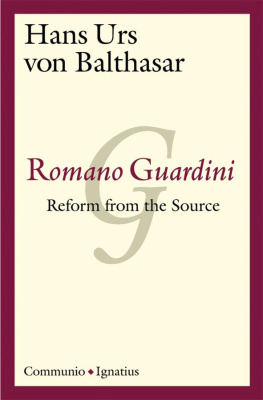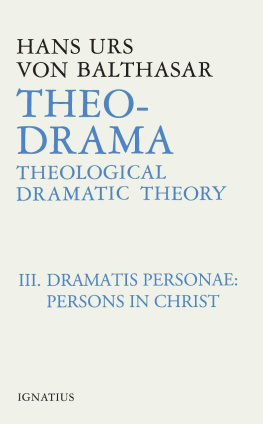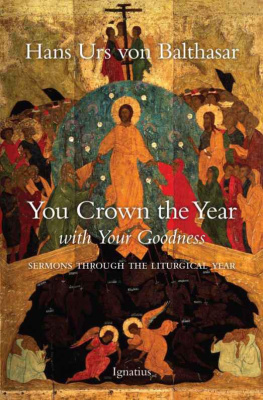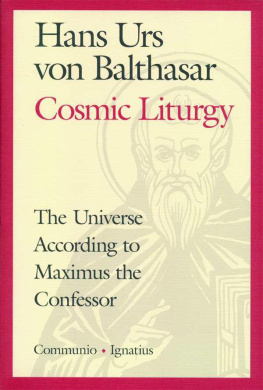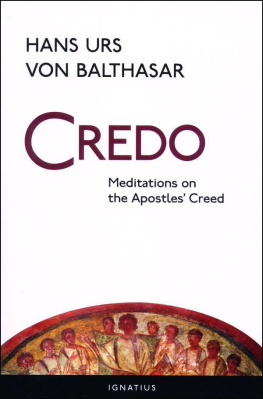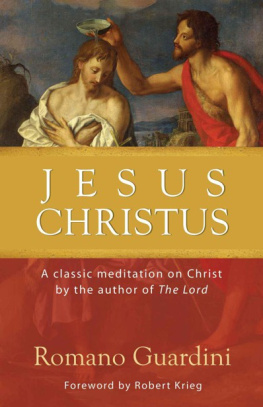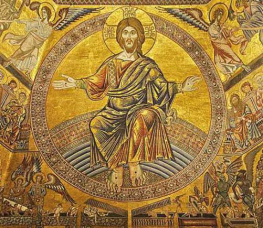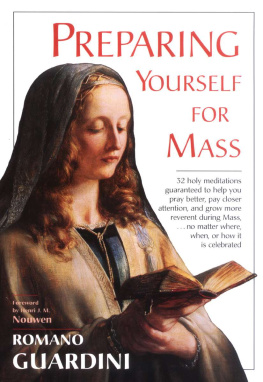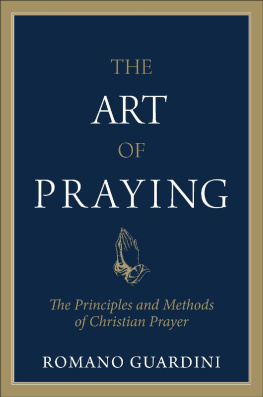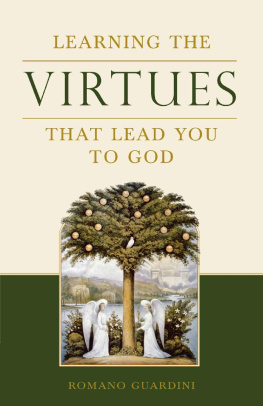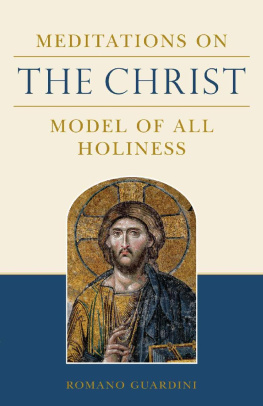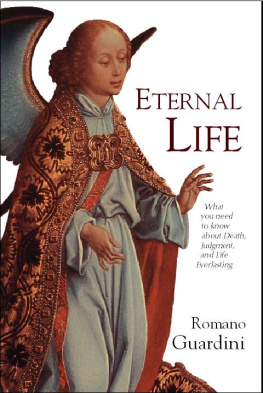ROMANO GUARDINI: REFORM FROM THE SOURCE
HANS URS VON BALTHASAR
ROMANO GUARDINI: REFORM FROM THE SOURCE
Translated by Albert K. Wimmer
and D. C. Schindler
A COMMUNIO BOOK
IGNATIUS PRESS SAN FRANCISCO
Title of the German original:
Romano Guardini: Reform aus dem Ursprung
New edition 1995 by Johannes Verlag, Einsiedeln, Freiburg
Cover by Roxanne Mei Lum
A COMMUNION BOOK
2010 by Ignatius Press, San Francisco
All rights reserved
ISBN 978-0-89870-522-5
Library of Congress Control Number 2008936286
Printed in the United States of America
CONTENTS
PREFACE
Reform means to return to the original form. The term source, however, suggests the rejection of any form, the pure and primal spring, the initial burst of life and youth. Or is the fundamental law of all worldly existence best expressed by this metaphor: glowing lava that solidifies into rock, which, in turn, must be destroyed (by revolution) in order to make room for new beginnings? Such was the Dionysian philosophy of life at the time when Guardini began his career. And it aptly describes also the pathos of our times. Romanothat is, the RomanGuardini viewed things differently. In order to substantiate his vision, he chose as his companions great works of art, in which the definitive form is always arising in the creative act with the original spring of life. The sources are also the most basic forms. Yet both remain mere stops along the road of Guardinis thought; he persistently and ever more exclusively strove toward his goal, that is, the unique source and the unique form. In doing so, he transcended not only art but also philosophy (which, since Plato, can offer as its highest ideal only the Good beyond Being and the unity that the form-creating, categorially classifying spirit only wistfully encircles). He sought the Christian reality, which alone offers what cannot be fathomed by human thought, namely, the Trinity and the Incarnation. Guardinis highly trained eye recognized what was absolutely incomparable and what permeated all existence here. This original source was for him the most present reality; he shunned any flight into the past or into the future, even if this ever-flowing source also unveiled every age to him. He wished to abide in the original event, marveling at it in a spirit of sincerity and faithfulness. He drank from the fountain and taught many to do likewise, savoring the source for half a century.
This overview of Guardinis oeuvre grew out of a memorial lecture at the Catholic Academy in Munich that honored the first anniversary of his death. It is my intention to offer mere guidelines here, a kind of roadmap across the difficult landscape of his work, highlighting certain leitmotifs and referring to the larger contexts of intellectual history. This book will not include any personal or biographical references. It aims instead to inquire into the ultimate intention and the ordering principle according to which that intention was carried out. The book will not relieve the reader of the burden of coming to terms with Guardinis work. Perhaps its succinct nature and simple format will challenge readers to pursue Guardinis thought in more detail or even provoke their resistance. One thing is certain: Guardini did not erect any vain structures at the edge of history; rather, he built shelters for entire generations, indeed, bulwarks against the encroaching desert. This house stands firm on solid rock, whether or not his style suits us. Those who have truly recognized his spirit will owe him a debt of gratitude, again and again, even if they are preparing to continue on farther.
WHERE GUARDINI STOOD
Watchman, how much longer will the night endure? Guardini hears this question time and again. Listening intently to the pulse of his time, giving shape to what he hears, he watches for the approaching hour with intensity, care, and concern. We are not fooled by the noble style and the constantly muted cadence of his sentences; it is part of his responsibility to be moderate even in his mode of expression. He does not fail to grasp the meaning of the slogans just because the words have changed. Perhaps he still speaks of culture at a time when we talk about the humanized world, or speaks of the State instead of society, or totalitarianism and atheism instead of Marxism. Yet he knows the essence of these phenomena and movements because he recognizes their origins and their impact.
There exist two strands in his work that seem to contradict one another: he walked tirelessly alongside World War I and its results, from one chaotic situation to another, and he did not stand idly by during the twelve years of horror and their reverberations until he was carried away in 1968, in the midst of the bombed-out spiritual and intellectual landscape that surrounds us today. The ground on which he trod was never secure; his probing foot invariably sought to make it walkable for those who followed after him. On the other hand, his approach from the very beginning was firm and determinedindeed, almost definitive. There is no noticeable development, nor can we detect any changes in his basic positions from 1920 to 1960. To be sure, accents shifted slightly, and his language became more sober and serious. But the challenges remain the same. Thus it is easy to take a position for or against him without distinguishing between various periods or positions he held. One either agrees or disagrees. It would be futile to ask whether he would have judged things differently today than he did yesterday. It will be beneficial to recall briefly the highlights of the familiar positions in his principal works, positions toward which he advanced and at which he subsequently stood fast.
Ever since his Briefe vom Comer See (Letters from Lake Como) (1927), his mind was made up. In a heartrending statement he insists that the old, humane culture has come to an end, a culture in which natural man, embedded in his own maturity and past, had humanized nature to such a degree that he became harmoniously at one in it and with it. And it is in the soil of this first culture that the seeds of death are already planted: All culture is acquired at the expense of sacrificing living reality.
The human being who lives in this artificial second world is referred to as the inhumane man.
This second world is a purely worldly world; in it religious experience, the direct perception of Gods reality, creativity, and cosmic rule, weaken more and more.
But what will become of man within his second world? If we pose the question this way, we will recognize, for instance, how all-pervasive specialization constricts personality, and in places where a certain universality is achieved, no genuine wholeness, but merely dilletantism emerges. We observe the weakening of living organizations as a result of the perfection of machines and institutions, while at the same time movements advocating the return to nature are sectarian. Or there are people who assert that science and scholarship ought not to concern themselves with values, that they are merely meant to research for the sake of research, regardless of the results. Art exists only for its own sake, and the effect it has on humanity is irrelevant. The achievements of technology are allegedly the acts of the superman, and they are not to be regulated. Politics exists to implement political power without regard to either the dignity or the happiness of human beings, and so on. In sum, the artificial world is no longer centered in man, and it fragments into individual spheres whose very lack of connectedness tears man apart and leads to deep-seated anarchy.
Before listening to the appeals that Guardini called out to this extremely dangerous situation, some preliminary remarks about the relationship between religious experience and Christian faith (which will be addressed in more detail later) will be in order. Certainly, Christian antiquity and the Middle Ages adapted Christian values to the world (in a kind of religious short circuit),
Next page
